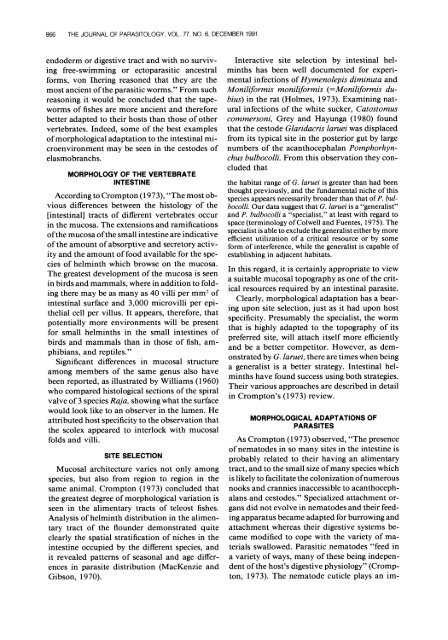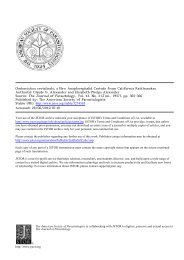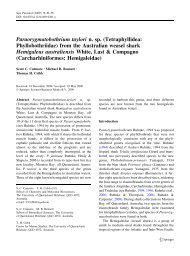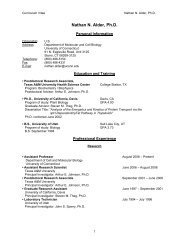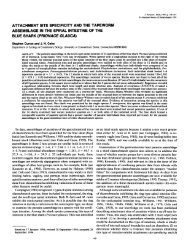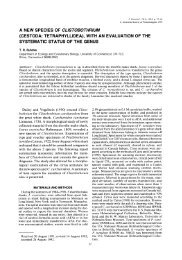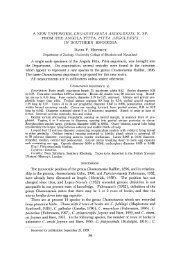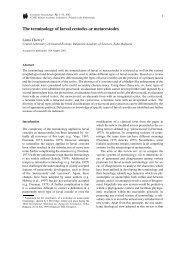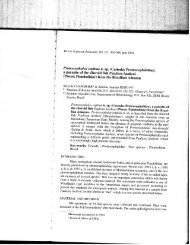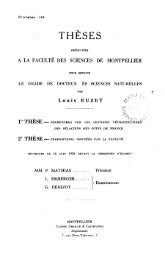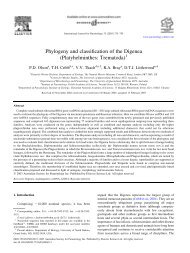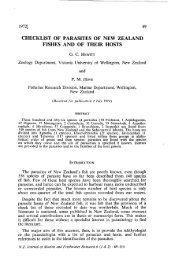Morphological Adaptations of Intestinal Helminths
Morphological Adaptations of Intestinal Helminths
Morphological Adaptations of Intestinal Helminths
You also want an ePaper? Increase the reach of your titles
YUMPU automatically turns print PDFs into web optimized ePapers that Google loves.
866 THE JOURNAL OF PARASITOLOGY, VOL. 77, NO. 6, DECEMBER 1991endoderm or digestive tract and with no survivingfree-swimming or ectoparasitic ancestralforms, von Ihering reasoned that they are themost ancient <strong>of</strong> the parasitic worms." From suchreasoning it would be concluded that the tapeworms<strong>of</strong> fishes are more ancient and thereforebetter adapted to their hosts than those <strong>of</strong> othervertebrates. Indeed, some <strong>of</strong> the best examples<strong>of</strong> morphological adaptation to the intestinal microenvironmentmay be seen in the cestodes <strong>of</strong>elasmobranchs.MORPHOLOGY OF THE VERTEBRATEINTESTINEAccording to Crompton (1973), "The most obviousdifferences between the histology <strong>of</strong> the[intestinal] tracts <strong>of</strong> different vertebrates occurin the mucosa. The extensions and ramifications<strong>of</strong> the mucosa <strong>of</strong> the small intestine are indicative<strong>of</strong> the amount <strong>of</strong> absorptive and secretory activityand the amount <strong>of</strong> food available for the species<strong>of</strong> helminth which browse on the mucosa.The greatest development <strong>of</strong> the mucosa is seenin birds and mammals, where in addition to foldingthere may be as many as 40 villi per mm2 <strong>of</strong>intestinal surface and 3,000 microvilli per epithelialcell per villus. It appears, therefore, thatpotentially more environments will be presentfor small helminths in the small intestines <strong>of</strong>birds and mammals than in those <strong>of</strong> fish, amphibians,and reptiles."Significant differences in mucosal structureamong members <strong>of</strong> the same genus also havebeen reported, as illustrated by Williams (1960)who compared histological sections <strong>of</strong> the spiralvalve <strong>of</strong> 3 species Raja, showing what the surfacewould look like to an observer in the lumen. Heattributed host specificity to the observation thatthe scolex appeared to interlock with mucosalfolds and villi.SITE SELECTIONMucosal architecture varies not only amongspecies, but also from region to region in thesame animal. Crompton (1973) concluded thatthe greatest degree <strong>of</strong> morphological variation isseen in the alimentary tracts <strong>of</strong> teleost fishes.Analysis <strong>of</strong> helminth distribution in the alimentarytract <strong>of</strong> the flounder demonstrated quiteclearly the spatial stratification <strong>of</strong> niches in theintestine occupied by the different species, andit revealed patterns <strong>of</strong> seasonal and age differencesin parasite distribution (MacKenzie andGibson, 1970).Interactive site selection by intestinal helminthshas been well documented for experimentalinfections <strong>of</strong> Hymenolepis diminuta andMoniliformis moniliformis (=Moniliformis dubius)in the rat (Holmes, 1973). Examining naturalinfections <strong>of</strong> the white sucker, Catostomuscommersoni, Grey and Hayunga (1980) foundthat the cestode Glaridacris laruei was displacedfrom its typical site in the posterior gut by largenumbers <strong>of</strong> the acanthocephalan Pomphorhynchusbulbocolli. From this observation they concludedthatthe habitat range <strong>of</strong> G. laruei is greater than had beenthought previously, and the fundamental niche <strong>of</strong> thisspecies appears necessarily broader than that <strong>of</strong> P. bulbocolli.Our data suggest that G. laruei is a "generalist"and P. bulbocolli a "specialist," at least with regard tospace (terminology <strong>of</strong> Colwell and Fuentes, 1975). Thespecialist is able to exclude the generalist either by moreefficient utilization <strong>of</strong> a critical resource or by someform <strong>of</strong> interference, while the generalist is capable <strong>of</strong>establishing in adjacent habitats.In this regard, it is certainly appropriate to viewa suitable mucosal topography as one <strong>of</strong> the criticalresources required by an intestinal parasite.Clearly, morphological adaptation has a bearingupon site selection, just as it had upon hostspecificity. Presumably the specialist, the wormthat is highly adapted to the topography <strong>of</strong> itspreferred site, will attach itself more efficientlyand be a better competitor. However, as demonstratedby G. laruei, there are times when beinga generalist is a better strategy. <strong>Intestinal</strong> helminthshave found success using both strategies.Their various approaches are described in detailin Crompton's (1973) review.MORPHOLOGICAL ADAPTATIONS OFPARASITESAs Crompton (1973) observed, "The presence<strong>of</strong> nematodes in so many sites in the intestine isprobably related to their having an alimentarytract, and to the small size <strong>of</strong> many species whichis likely to facilitate the colonization <strong>of</strong> numerousnooks and crannies inaccessible to acanthocephalansand cestodes." Specialized attachment organsdid not evolve in nematodes and their feedingapparatus became adapted for burrowing andattachment whereas their digestive systems becamemodified to cope with the variety <strong>of</strong> materialsswallowed. Parasitic nematodes "feed ina variety <strong>of</strong> ways, many <strong>of</strong> these being independent<strong>of</strong> the host's digestive physiology" (Crompton,1973). The nematode cuticle plays an im-


